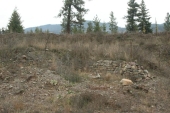
 8
8




Using texture in the earth, you can block harmful winds or channel them to places where they can be more useful.
Wind dries the soil and blows it away.
Less wind will reduce or eliminate wind chill factor.
Berms dramatically reduce wind.
Berms are the best at reducing unwanted noise.
Water transpired from the plants during the day is more likely to return to the plants as morning dew.
 9
9





 7
7




Hans Albert Quistorff, LMT projects on permies Hans Massage Qberry Farm magnet therapy gmail hquistorff
 2
2













I have started a community garden and food forest near a low income area of town. the north edge of the property abutts a railroad track. it is a spur that Cargill uses for its soybean meal plant. They spray the side of the railroad tracks with herbicide. Would a berm be a good way to prevent drift and such from them?
A berm would dramatically reduce problems.

"Never doubt that a small group of thoughtful, committed citizens can change the world; indeed, it's the only thing that ever has."-Margaret Mead "The only thing worse than being blind, is having sight but no vision."-Helen Keller
 1
1


















 I had to put that here. So anyway, one reason that those sunchoke plants on top of your berm are doing so well even though we might think that there is not much moisture there, is because there actually is moisture there! The reason that there is moisture there, is because of evaporation off the surface of the berm (which has a large surface area) and evapo-transpiration from the plants. These evaporation processes creates a capillary draw from the water rich soil particles within the berm's center and under the base of the berm.
I had to put that here. So anyway, one reason that those sunchoke plants on top of your berm are doing so well even though we might think that there is not much moisture there, is because there actually is moisture there! The reason that there is moisture there, is because of evaporation off the surface of the berm (which has a large surface area) and evapo-transpiration from the plants. These evaporation processes creates a capillary draw from the water rich soil particles within the berm's center and under the base of the berm. "Never doubt that a small group of thoughtful, committed citizens can change the world; indeed, it's the only thing that ever has."-Margaret Mead "The only thing worse than being blind, is having sight but no vision."-Helen Keller














That sounds great! Great to hear of another community garden!I would probably build a bear 20 ft away and the gardens would be farther. I doubt that I would use the berm for food. Just a barrier between the railroad and garden.
"Never doubt that a small group of thoughtful, committed citizens can change the world; indeed, it's the only thing that ever has."-Margaret Mead "The only thing worse than being blind, is having sight but no vision."-Helen Keller
 1
1















 3
3





This would depend on whether you have the water capacity to irrigate. Some people might not have that capacity, and then it might be better to wait until closer to rain. I would say, irrigation or rain is very beneficial for starting berms off.When seeding new earth works during drought periods, is it recommended to seed immediately and wait for the first rains to sprout the seeds? Is it better to wait until closer to the rainy season and then seed? Will this lead to lower germination due to rotting and wildlife forage if rainy season is 4-5 months away? Don't want the soil to runoff but we don't want to waste seed if we don't have to.
I think that if you have the capacity to charge your berms with moisture while you build them, or shortly thereafter, then you should. I'm assuming that since you asked, that you do have the capacity. The sooner they have moisture, the faster you will gain the benefits from them. A drip irrigation, or weeping hose, on the top of your berm will go a long way to penetrating the whole thing slowly with very little volume of water/hour/day. If you have a windier part of the day, and you have limited water, then irrigate when that part of the day ends, so you loose as little moisture to evaporation. If it's windy all the time, irrigate at night when you have less heat evaporation.How important is it to get the new beds irrigated? It seems like Geoff does irrigate his new earthworks immediately.
Straw might be better as hay has seeds that may attract wildlife. You may want those seeds though, in your berm, depending on the hay seed, and if you don't mind those plants.we plan to use hay mulch to protect from wind and wildlife.
"Never doubt that a small group of thoughtful, committed citizens can change the world; indeed, it's the only thing that ever has."-Margaret Mead "The only thing worse than being blind, is having sight but no vision."-Helen Keller
 1
1




Ben Allan wrote:When seeding new earth works during drought periods, is it recommended to seed immediately and wait for the first rains to sprout the seeds? Is it better to wait until closer to the rainy season and then seed? Will this lead to lower germination due to rotting and wildlife forage if rainy season is 4-5 months away?
How important is it to get the new beds irrigated? It seems like Geoff does irrigate his new earthworks immediately.
Roberto pokachinni wrote:I think that if you have the capacity to charge your berms with moisture while you build them, or shortly thereafter, then you should.
Ben Allan wrote:we plan to use hay mulch to protect from wind and wildlife.
Roberto pokachinni wrote:Straw might be better as hay has seeds that may attract wildlife.
 2
2




Instead of irrigation, we used patience. What a beautiful, magnificent and noble ingredient .... patience.







 1
1




Roberto pokachinni wrote:About Berms:
Hi Paul. Berms are awesome!!I had to put that here. So anyway, one reason that those sunchoke plants on top of your berm are doing so well even though we might think that there is not much moisture there, is because there actually is moisture there! The reason that there is moisture there, is because of evaporation off the surface of the berm (which has a large surface area) and evapo-transpiration from the plants. These evaporation processes creates a capillary draw from the water rich soil particles within the berm's center and under the base of the berm.
Support my videos by becoming a Patron
QR code for Bitcoin donations
www.oneheartfire.org to follow my personal permaculture adventures.
Now accepting Gappers for the Permaculture Bike Park project.
My Ant Love wish list:
Biodegradable Bar Oil for my chainsaw. I'm gonna need a lot of this for milling lumber with my chainsaw mill.
Darn Tough Socks that come with an unconditional lifetime warrantee! I go through socks like goats through a fence, these are supposed to last a lifetime or they send you a new pair! Size 12/XL please










 1
1




There is quite a remarkable amount of increased surface are, and thus growing space. Mostly I would think the gains will be in water retention, and micro climates, and cool visual effect!turn 1 acre of flat growing surface, into almost 2 acres of growing surface by building berms all over it.
"Never doubt that a small group of thoughtful, committed citizens can change the world; indeed, it's the only thing that ever has."-Margaret Mead "The only thing worse than being blind, is having sight but no vision."-Helen Keller
 3
3





This is a picture of a sad little apple tree that was run over by somebody - it was broken and fred tried to repair it with a little masking tape. And the rhubarb was also pretty small and pathetic. And some alfalfa we planted eventually took off. This is on a berm that is pretty much just rock and sand. There is no hugelkultur element (woody bits - or any other organic matter) inside.
Zero irrigation.
And when this picture was taken, all other rhubarb had gone fully dormant, and all other apple trees had dropped their leaves. But the rhubarb looks vibrant and green, and the apple tree looks pretty green, with a leaf count showing strong health.
Alfalfa is a nitrogen fixer with a deep tap root. I think this picture is evidence of the alfalfa finding water and sharing it with the apple tree and the rhubarb.















Hans Albert Quistorff, LMT projects on permies Hans Massage Qberry Farm magnet therapy gmail hquistorff





|
There's a hole in the bucket, dear Liza, dear Liza, a hole in the bucket, dear liza, a tiny ad:
The new kickstarter is now live!
https://www.kickstarter.com/projects/paulwheaton/garden-cards
|









